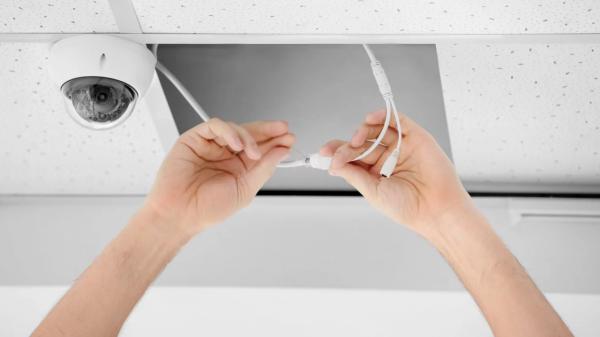

Revolutionizing Surveillance: Understanding PoE Security Cameras
In recent years, security cameras have gained significant traction among homeowners and businesses alike. Innovations in technology have played a crucial role in enhancing the accessibility and user-friendliness of surveillance systems. A notable advancement in this field is Power over Ethernet (PoE), which simplifies the installation of professional-grade security camera setups and broadens their appeal.
PoE technology enables both power and data to be transmitted through a single cable, streamlining the setup process for security camera systems and potentially reducing costs. This article explores the advantages of PoE security cameras and how utilizing Ethernet cabling can lead to savings.
PoE cameras, often referred to as network or IP security cameras, are designed with built-in Power over Ethernet functionality. This allows them to receive power and send video data through a single network cable. The combination of power and data transmission makes PoE cameras an excellent option for security installations.
It’s important to clarify that not all IP cameras come with PoE capabilities. Cameras lacking this feature require separate power adapters. While various camera types can connect via PoE, larger models like PTZ cameras might not support it. Similarly, wireless security cameras do not use PoE, typically relying on an external 12V DC adapter for power.
When connected to a compatible network video recorder (NVR), PoE cameras provide a straightforward “plug-and-play” experience, removing the complexities associated with setup. While professional installation is advisable, PoE technology simplifies troubleshooting and repairs.
To fully grasp PoE camera systems, it’s essential to understand the different types of CCTV security setups available. Here’s a concise overview:
Among the earliest forms of security camera technology, analog systems use coaxial cables. Modern variants can record HD video, often through HDCVI connections. These systems necessitate a digital video recorder (DVR) to convert analog signals into digital formats. Unlike PoE systems, analog cameras require separate cables for video and power transmission. While Siamese coaxial cables can combine these functions, they don’t match the convenience of PoE.
IP cameras use computer networking protocols and cables to digitally transmit video to NVRs, computers, or mobile devices. They can operate independently without a recorder, although an internet connection is required for remote viewing. Both PoE and WiFi security cameras fall into this category.
PoE camera systems specifically utilize IP cameras that feature built-in PoE technology, enabling power and video data transmission through a single cable. Typically, NVRs in these systems include an internal PoE switch, allowing for a seamless connection that enables cameras to power on and start recording within minutes.
These systems leverage WiFi technology similar to that of smartphones and tablets. While wireless cameras can be battery-operated, those requiring a constant power supply often need special adapters. Their effectiveness is maximized with minimal obstructions between the WiFi router and the cameras, making them suitable for diverse applications, from remote monitoring to residential security.
To set up a PoE camera system, several components are necessary:
PoE cameras
Network video recorder (NVR)
Ethernet cables (such as CAT5e or CAT6)
An external PoE switch (for some setups)
A monitor or TV for system output (remote access through phones or computers is possible after setup)
In a PoE configuration, cameras encode video before sending it to the NVR for recording or remote access. There are two primary types of systems: plug-and-play and those functioning over local networks.
In a plug-and-play setup, the NVR includes a built-in PoE switch, allowing cameras to connect directly to it. Each camera uses an Ethernet cable linked to the NVR’s PoE switch. For example, a 4-channel NVR accommodates up to four cameras, while larger models support more connections. This type of system is user-friendly, as cameras power on and transmit video shortly after being connected.
Alternatively, PoE systems can operate over a local network with external PoE switches. This configuration is more complex, requiring manual setup for each camera. External switches feature PoE ports for power and data, along with uplink ports for connecting to networking equipment. This allows the NVR to be situated anywhere within the network, with cameras sending data through the switches. Each camera needs a unique IP address on the network, which can pose a challenge for those less familiar with networking.
Choosing to set up PoE security cameras over a local network rather than a plug-and-play system offers several advantages:
Scalability: Connecting PoE cameras through a local network allows for easier expansion. While plug-and-play systems are limited by the NVR's available ports, local network setups can accommodate additional cameras through extra PoE switches.
Extended Distance: Local network systems can extend the distance between cameras and the NVR by strategically placing PoE switches, allowing for longer cable runs.
Utilization of Existing Infrastructure: Leveraging a local network can optimize existing infrastructure, making it unnecessary to lay additional cabling for the cameras.
Centralized Management: Managing PoE cameras on a local network allows for centralized control, facilitating easier maintenance and monitoring.
Integration with Other Devices: Using a local network allows for seamless integration with other devices, enabling advanced functionalities and a more comprehensive security solution.
Setting up PoE cameras on a local network requires a level of networking knowledge, but for those comfortable with it, this approach offers greater flexibility and control.
PoE technology has transformed the security camera landscape by simplifying the setup for residential and commercial applications. Users can achieve a plug-and-play installation with minimal technical know-how, but it’s advisable to consult a reputable installer for optimal product selection and placement.
Once properly installed, users can fully benefit from the versatility and convenience that PoE technology provides. Here’s a summary of its key advantages:
High-Quality Footage: PoE IP cameras have built-in processors for encoding, allowing for superior video quality and resolution compared to analog systems. This digital transmission minimizes signal loss, resulting in clearer footage for investigations.
Flexibility: Ethernet cables are easier to work with than coaxial cables, allowing for installation in more challenging locations. Although Ethernet has a maximum run of 328 feet, PoE extenders can help overcome this limitation.
Convenience and Cost Savings: The dual functionality of power and data in a single cable streamlines the installation process, reducing costs and simplifying relocations or additions to the system.
Remote Accessibility: By connecting the NVR to the internet, users can access live feeds and recorded footage from anywhere, enhancing security and connectivity.
Integration with Network Infrastructure: PoE cameras work seamlessly with existing network systems, allowing for centralized management and advanced features that improve the overall functionality of the surveillance setup.
Articles
All articles
AI Surveillance Systems: Transforming Safety and Operational Efficiency in Modern Shopping Malls
AI Surveillance Systems: Transforming Safety and Operational Efficiency in Modern Shopping Malls

The Advantages of a Comprehensive Home Surveillance System
The Advantages of a Comprehensive Home Surveillance System

Seeing Clearly: The Advantages of 4K Surveillance for Businesses
Seeing Clearly: The Advantages of 4K Surveillance for Businesses

Indoor vs. Outdoor Security Cameras: Making the Right Choice for Your Safety
Indoor vs. Outdoor Security Cameras: Making the Right Choice for Your Safety

The Smart Investment: How Monitored Security Cameras Enhance Business Safety
The Smart Investment: How Monitored Security Cameras Enhance Business Safety

2024 Security Camera Buying Guide: What You Need to Know
2024 Security Camera Buying Guide: What You Need to Know

Essential Guide to Troubleshooting IP Camera Systems
Essential Guide to Troubleshooting IP Camera Systems

Artificial Intelligence: Transforming IP Camera Systems
Artificial Intelligence: Transforming IP Camera Systems

Thermal Cameras: Enhancing Security and Operational Excellence Across Industries
Thermal Cameras: Enhancing Security and Operational Excellence Across Industries

Maximizing Safety and Efficiency: The Impact of IP Camera Systems Across Industries
Maximizing Safety and Efficiency: The Impact of IP Camera Systems Across Industries

Beyond Security: How Surveillance Cameras Transform Shipping and Receiving Operations
Beyond Security: How Surveillance Cameras Transform Shipping and Receiving Operations

Enhancing Safety: The Essential Role of Security Camera Systems in Apartment Complexes
Enhancing Safety: The Essential Role of Security Camera Systems in Apartment Complexes

Is a PTZ Camera the Right Choice for Your Business?
Is a PTZ Camera the Right Choice for Your Business?

Troubleshooting Nighttime Flickering: Understanding Your Security Camera Issues
Troubleshooting Nighttime Flickering: Understanding Your Security Camera Issues

Why Are My Cameras Showing Black and White Images?
Why Are My Cameras Showing Black and White Images?

Safeguarding Your Security Cameras from Hackers
Safeguarding Your Security Cameras from Hackers

A Comprehensive Guide to Security Camera Cabling: Types, Failures, and Solutions
A Comprehensive Guide to Security Camera Cabling: Types, Failures, and Solutions

Securing the Aggregate Industry: The Essential Role of Surveillance Cameras
Securing the Aggregate Industry: The Essential Role of Surveillance Cameras

Security Cameras: A Comprehensive Overview of Types and Features
Security Cameras: A Comprehensive Overview of Types and Features

Protecting Your Car Wash: Essential Security Measures Against Theft and False Claims
Protecting Your Car Wash: Essential Security Measures Against Theft and False Claims
Try TRASSIR For Your Business
Learn more about how TRASSIR analytic modules work! Demo mode is an opportunity to see for yourself how the system works, and also check the interface and test all the functions.Success!
We will contact you as soon as possible